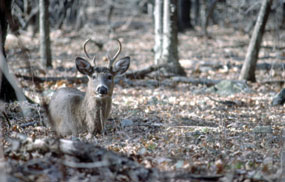 |
| White-tailed deer abound in Shenandoah National Park |
 |
Shenandoah serves as a refuge for many species of animals otherwise pressured by human activities, development and other land uses. There are over 200 resident and transient bird species, over 50 species of mammals, 51 reptile and amphibian species, and 30 fish species found in the park. Only incomplete records of insects, spiders, and other invertebrates are available so the total number of different species of these groups is unknown. A handful of these species are large and conspicuous and therefore easily found by visitors. The park provides boundless opportunities for the public to search for and discover the thousands of other park residents.
Those who explored the Shenandoah Valley and Blue Ridge Mountains in the early 1700s reported an abundance and variety of animals. As European settlers cleared the land, introduced domestic animals, and hunted native animals, the abundance and variety in species diminished. An unknown number of native species disappeared from the area, while populations of many other species dwindled. American bison were eliminated around 1798 and elk followed in 1855. Beaver and river otter disappeared in the late 1800s. Other species, including the eastern timber wolf, the eastern cougar, the white-tailed deer, turkey, black bear, and bobcats were either extirpated or declined drastically.
Fortunately, most of these species have now returned to the park either through re-introductions on lands elsewhere in Virginia or through natural population recovery. The designation and management of the area as a National Park provides refuge to both the resident animals and those that are passing through on their migrations.
Today, Shenandoah National Park is a great place to observe wildlife. Countless visitors spend hours watching deer snip and tear plants. Other people look for tracks and scat of bobcats, listen for the rustling of raccoons in the brush, and occasionally smell striped skunks. The opossum, groundhog, gray fox, and eastern cottontail are more commonly seen mammals in the park.
Because close contact with people is frequent and hunting and trapping are prohibited, some animals appear almost tame. They are wild, however. Even beautiful brown-eyed deer will defend their young from harm. Their elegant legs are powerful and their hooves are sharp; facts some visitors insist on learning the hard way.
|






